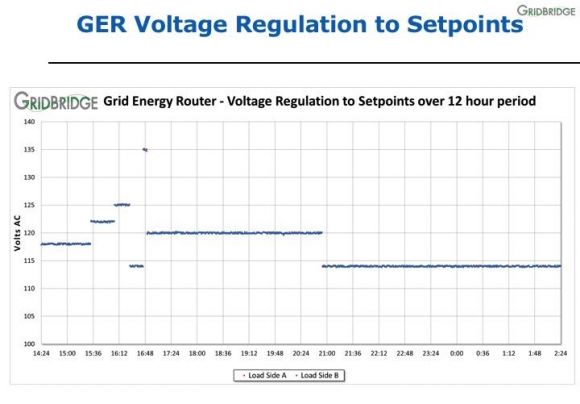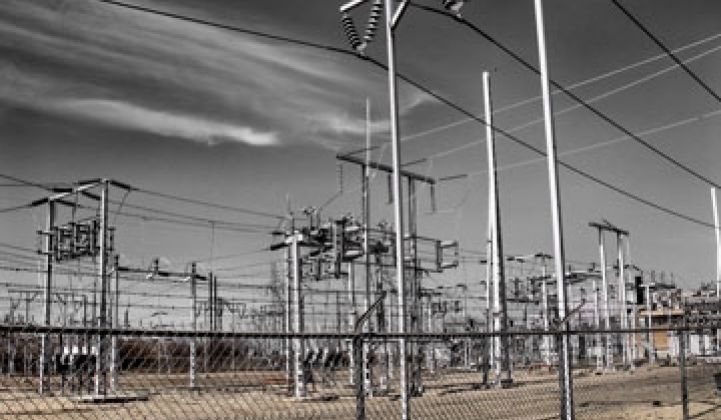In the past two weeks, we’ve highlighted how next-generation grid power electronics control systems from startups Gridco and Varentec have been proving their ability to manage voltages on the edges of utility distribution grids in real-world utility pilot projects. Now we’ve got some more data from a third player in this emerging field -- GridBridge.
Over the past year, the North Carolina State University spinout has been piloting its devices with hometown utility Duke Energy. Last week, GridBridge CEO Chad Eckhardt shared some of the data from those pilots -- and the results look promising.
Here are two graphs that show how GridBridge’s devices were able to both stabilize fluctuating circuit voltages to a more efficient lower voltage and dynamically adjust voltage set points on the same circuits. In both cases, the devices were installed next to 50 kVa distribution transformers, Eckhardt said.
“There are three aspects that are important to utilities,” he said. “The device should function as originally intended to; it should be thermally stable; and it should be in an enclosure that [can] withstand the environmental conditions. I’m proud to say we accomplished each one of those” with GridBridge’s devices.
As for how they performed their tasks, this first chart shows how a GridBridge device was able to take input voltages fluctuating between 121 and 124 volts and flatten them out to 120 volts on the load side of the device over a 24-hour period.

That’s a valuable capability for utilities trying to enable conservation voltage reduction (CVR) and volt/VAR optimization (VVO) schemes that lower voltages to improve the efficiency of how the grid delivers power to its end users. Centrally managed VVO and CVR methods can’t control individual circuits and feeders. While electromechanical devices like line tap changers and capacitor banks can accomplish this kind of circuit-by-circuit control, they aren’t as fine-grained or fast-responding as power electronics, and can wear out more quickly when asked to perform voltage-altering actions too often.
Beyond keeping voltages at a steady state, GridBridge was also able to demonstrate the ability to adjust voltages on the fly. The following chart shows how one device was able to change voltages between a wide range, both up and down, based on utility commands. That’s an important capability for managing circuits that may be pushed below minimum voltages by changing daily conditions, or pushed toward higher bounds by the effects of solar PV systems feeding power back up the power line, to name two examples.

“In order to really demonstrate the instantaneous capabilities of our device, we changed the setpoint in one case from 114 V to 135 V, which is really impressive,” Eckhardt said. “Throughout the timeline, the output voltage stays constant.”
GTM Research has projected that the U.S. market for distribution grid power electronics systems like these will reach $320 million in 2017, for a compound annual growth rate of 134 percent over the next three years. That’s driven not only by the need to improve CVR and VVO performance and gain more efficiency from existing investments in this area, but also by the need to monitor, manage and optimize grid conditions on circuits with an increasing amount of solar PV and other distributed energy resources largely outside utility control.
“Whether it’s CVR, whether it’s PV variability, whether it’s reduction of the need for traditional electromechanical equipment -- there’s value in that voltage capability,” Eckhardt said. But voltage is just one of the key grid conditions that these types of devices can help manage for utilities, he noted -- reactive power optimization, power factor correction, and grid harmonics stabilization are also on the list.
GridBridge is also envisioning future uses that could help manage the interplay of solar PV inverters and other distributed energy resources in the form of a “nanogrid,” or by turning these networked combinations of distributed energy assets into more controllable nodes of grid interactivity. Similar concepts are being worked on by companies including ABB and Cree, two firms that share membership with GridBridge in a federally funded semiconductor research hub in North Carolina.
GridBridge raised about $500,000 in late 2014, part of what Eckhardt described as a Series A investment round that has raised an amount in the “millions of dollars” range. It has also landed contracts with NASA to develop technology for aerospace applications, and won a $700,000 small business innovation research (SBIR) grant in September.
That’s not a lot of money compared to the amounts raised by Varentec and Gridco, but it’s in keeping with GridBridge’s goal of managing its business in as capital-efficient a manner as possible, he said. It’s taken years for companies like these to get to their first utility pilots -- and while early tests are promising, it takes a long time for novel technologies like this to transition from pilot projects to active components of the grid at large.
***
Greentech Media will be covering the emergence of power electronics for distribution grid control at our upcoming Grid Edge Live 2015 conference, set for June 24-25 in San Diego, Calif.



